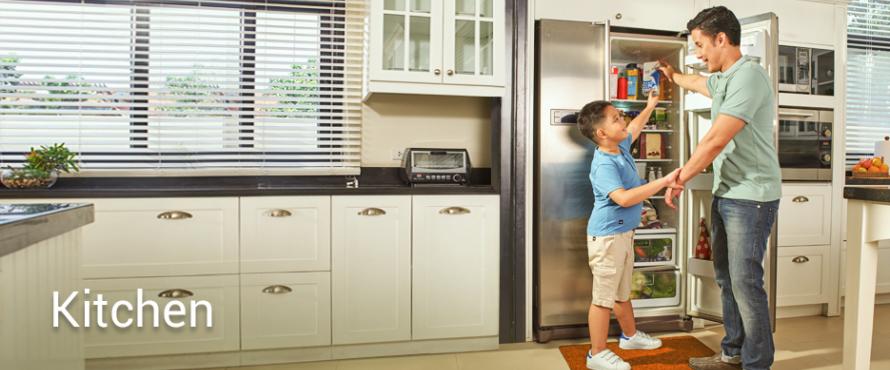Tips for the Kitchen

Induction Heat Cooker: A recipe for better efficiency
INDUCTION HEAT COOKER
Based on Power Lab Tests, induction Cookers are more efficient (82%) than gas (36%) and electric (coil-type) stoves (36%). Induction cookers also cook faster, create less ambient heat so you save on space cooling costs, have precise cooking temperature and time, and are safe from gas leaks and explosions.
Oven and Microwave: Baking up new solutions
OVEN and MICROWAVE
A microwave oven is an energy efficient alternative to a conventional oven. It cooks food faster because the energy heats only the food and not the oven compartment. If available, use a microwave or toaster oven for warming leftovers. They use up to 30% less energy than regular ovens. To lessen costs further, use glass pans. Glass retains heat, so you can set the oven to a lower temperature.
Keep it closed. Refrain from looking inside a working oven too often and instead use the oven light to check on the food. Twenty percent (20%) of the heat can be lost each time you open the oven door.
Turn it off. Turn the oven off before cooking is complete (up to 15 minutes, depending on the dish). The heat in the oven will continue to cook the dish until finished. Also, keep preheating to a minimum.
Refrigerator: Tips and tricks to freeze rising costs
REFRIGERATOR
Choose the right one. Check the attached yellow label. Units with a higher Energy Efficiency Factor cost less to operate. Also, pick the right size for your family. As a rule of thumb, a 7 to 10-cubic foot ref generally holds a food capacity for two people. Add an extra cubic foot for each additional person in the household. If the refrigerator is too big and you don't keep it filled, it wastes energy and costs more to operate.
Consider Inverter Technology. If you’re looking for a new refrigerator, consider inverter refrigerators as they are more efficient versus conventional units. Based on Power Lab tests, save as much as 50% on refrigerator costs.
Keep it full, but do not overload. Keep refrigerators at least two-thirds full to allow for proper air circulation of cool air inside. This keeps your food properly chilled. Overfilling the refrigerator hinders the cold airflow, reducing its efficiency. For manual refrigerators, when there is already 1/4 inch frost build up, defrost it. Too much frost also makes your unit operate inefficiently.
Provide proper air circulation and location. Keep at least a 2-inch gap behind the refrigerator and on all sides to let air to circulate. This prevents the motor from overworking and allows efficient heat release from the condenser coils. Don't position your refrigerator in direct sunlight or near heat-producing appliances like the stove.
Store food properly. Don’t store hot food. Let it cool to room temperature first or your refrigerator has to work harder to bring the temperature down. Also, cover liquids, wrap food, and wipe off moisture from containers. Uncovered food releases moisture, which makes the compressor work harder and also causes excessive build-up of ice in your freezer.
Take the paper test. Close the refrigerator door on a piece of paper. If you can pull it out easily or it falls, it means the door seals aren’t working and won’t keep the cold in. That means it uses more energy to keep your food cold. It’s time for some repairs.
Mind the door. It will also help if you minimize the time the refrigerator door is open. Avoid unnecessary opening. Before opening, consider what you would like to take and where it's placed inside the refrigerator. Avoid choosing or thinking what to take while the door is open.
Rice Cooker: Time-tested hacks
RICE COOKER
Check your ‘Keep Warm’ function. Rice cookers have a ‘Keep Warm’ function that maintains the appropriate amount of heat needed to keep rice warm after it is cooked. Instead of relying on this function, schedule when you’ll cook rice closer to your eating time. After using your rice cooker and every time it is not in use, unplug the power cord.
Clean your rice cookers. Make sure that the inner pot and hot plate are free from any form of impurities such as burnt grains of rice or hardened food. The surface of the plate should be well cleaned and smooth to allow complete contact with the inner pot. This will ensure efficient and even heating.
Choose the appropriate size of rice cooker. Choose the right rice cooker size according to your household needs. An oversized rice cooker would consume more energy than a properly sized rice cooker.
Stove Top: Big appliances don’t have to mean bigger costs
STOVETOP
Plan ahead. Prepare all ingredients before cooking to avoid frequent switching of the electric stove. Thaw frozen food thoroughly before cooking.
Match pots and pans with your stove. Avoid using a big burner for a small pan to lessen heat transfer loss. This saves up to 25% of the electricity you use while cooking. It also helps to use flat-bottomed pots and pans as they allow faster heat transfer and use up to 50% less energy. Cover pots and pans with lids while cooking to prevent heat from escaping.
Save the heat. Turn off the electric stove during the last minutes of cooking. The remaining heat will be enough to keep the food simmering.


